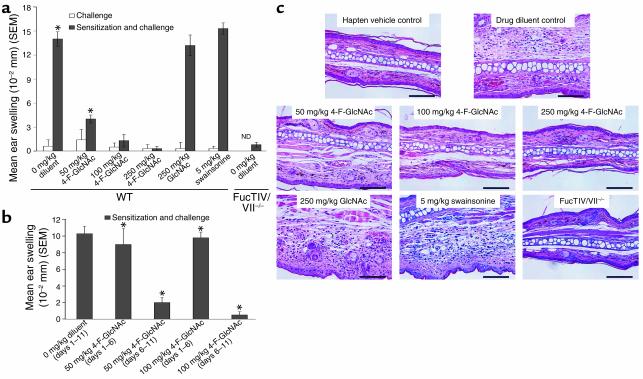Figure 2.
Allergic CHS in mice treated with 4-F-GlcNAc. (a) Wild-type mice were sensitized on the abdomen with 0.5% DNFB in vehicle (acetone/olive oil, 4:1) on days 0 and 1. Mice were given 0.9% saline (diluent), 50, 100, or 250 mg/kg 4-F-GlcNAc, 5 mg/kg swainsonine, or 250 mg/kg GlcNAc (negative drug control) intraperitoneally daily from day 1 to day 6. FucTIV/VII–null mice were also sensitized with 0.5% DNFB and treated with diluent control. Mice were then challenged on the right ear on day 6 with 0.25% DNFB and on the left ear with vehicle alone. After 24 hours, ear swelling was determined by measurement of ear thickness, which was subtracted from base-line ear-thickness measurements. *P < 0.0002, Student’s paired t test. ND, not determined. (b) Wild-type mice were sensitized on the abdomen with 0.5% DNFB on days 0 and 1. Mice were given diluent control or 50 or 100 mg/kg 4-F-GlcNAc intraperitoneally daily either from day 1 to day 6 or from day 6 to day 11. Mice were then challenged on the right ear on day 11 with 0.25% DNFB and on the left ear with vehicle alone. After 24 hours, ear swelling was determined. *P < 0.007, Student’s paired t test. Data in a and b represent mean ear swelling ± SEM from eight mice per group and three experiments. (c) Representative photomicrographs of H&E-stained sections from ears of mice sensitized and challenged with 0.5% DNFB illustrate differences in ear thickness between mice treated with diluent control and with 4-F-GlcNAc. ×200 magnification. Bar: 100 μm.

